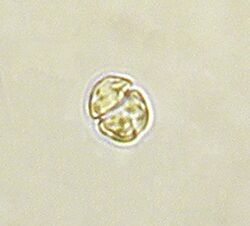Biology:Gymnodinium
| Gymnodinium | |
|---|---|

| |
| Scientific classification | |
| Domain: | Eukaryota |
| Clade: | Diaphoretickes |
| Clade: | SAR |
| Clade: | Alveolata |
| Phylum: | Myzozoa |
| Superclass: | Dinoflagellata |
| Class: | Dinophyceae |
| Order: | Gymnodiniales |
| Family: | Gymnodiniaceae |
| Genus: | Gymnodinium Stein, 1878 |
Gymnodinium is a genus of dinoflagellates, a type of marine and freshwater plankton. It is one of the few naked dinoflagellates, or species lacking armor known as cellulosic plates. Since 2000, the species which had been considered to be part of Gymnodinium have been divided into several genera, based on the nature of the apical groove and partial LSU rDNA sequence data.[1] Amphidinium was redefined later.[2][3] Gymnodinium belong to red dinoflagellates that, in concentration, can cause red tides.[4] The red tides produced by some Gymnodinium, such as Gymnodinium catenatum, are toxic and pose risks to marine and human life, including paralytic shellfish poisoning.[5][6][7]
Segregate genera
- Gymnodinium sensu stricto
- Akashiwo
- Amphidinium
- Gyrodinium
- Karenia
- Karlodinium
- Katodinium
Former species
Torodinium (with Torodinium robustum and the type species Torodinium teredo) were both formerly Gymnodinium teredo until 1921.[8]
References
- ↑ Daugbjerg, N.; Hansen, G.; Larsen, J.; Moestrup, Ø. (2000). "Phylogeny of some of the major genera of dinoflagellates based on ultrastructure and partial LSU rDNA sequence data, including the erection of three new genera of unarmoured dinoflagellates". Phycologia 39 (4): 302–317. doi:10.2216/i0031-8884-39-4-302.1.
- ↑ Jorgensen, M. Flo; Murray, S.; Daugbjerg, N. (2004). "Amphidinium revisited. I. Redefinition of Amphidinium (Dinophyceae) based on cladistic and molecular phylogenetic analysis". Journal of Phycology 40 (2): 351–365. doi:10.1111/j.1529-8817.2004.03131.x.
- ↑ Murray, S.; Flo Jorgensen, M.; Daugbjerg, N.; Rhodes, L. (2004). "Amphidinium revisited. II. Resolving species boundaries in the Amphidinium operculatum species complex (Dinophyceae), including the descriptions of Amphidinium trulla sp. nov. and Amphidinium gibbosum comb. nov". Journal of Phycology 40 (2): 366–382. doi:10.1046/j.1529-8817.2004.03132.x.
- ↑ Rollo, Franco; Sassarolil, Stefano; Boni, Laurita; Marota, Isolina (1995-04-28). "Molecular typing of the red-tide dinoflagellate Gonyaulax polyedra in phytoplankton suspensions". Aquatic Microbial Ecology 9: 55. doi:10.3354/ame009055. https://www.int-res.com/articles/ame/9/a009p055.pdf. Retrieved 2015-04-25.
- ↑ Heimann, Kirsten (2012). "Gymnodiniumand Related Dinoflagellates". Gymnodinium and Related Dinoflagellates. John Wiley & Sons, Ltd. doi:10.1002/9780470015902.a0001967.pub2. ISBN 978-0470016176. https://doi.org/10.1002/9780470015902.a0001967.pub2.
- ↑ Mee, Laurence D.; Espinosa, Mayola; Diaz, Gilberto (1986). "Paralytic shellfish poisoning with a gymnodinium catenatum red tide on the Pacific coast of Mexico". Marine Environmental Research (Elsevier) 19 (1): 77–92. doi:10.1016/0141-1136(86)90040-1. Bibcode: 1986MarER..19...77M. https://dx.doi.org/10.1016/0141-1136%2886%2990040-1.
- ↑ Ramirez, Camarena; Cortes, Altamirano; Munoz, Cabrera (1999). "Red tide caused by the dinoflagellate Gymnodinium catenatum off Mazatlan Bay, Sinaloa, Mexico in 1997". Revista de Biología Tropical 47: 77–80.
- ↑ Kofoid, C.A. and Swezy, O. 1921: The free-living unarmored dinoflagellate. University of California Press, Berkeley, California, USA
Further reading
- Estrada, Norma; Ascencio, Felipe; Shoshani, Liora (December 2014). "Apoptosis of hemocytes from lions-paw scallop Nodipecten subnodosus induced with paralyzing shellfish poison from Gymnodinium catenatum". Contreras 219 (12): 964–974. doi:10.1016/j.imbio.2014.07.006. PMID 25097151.
- Thessen, Annie E.; Patterson, David J.; Murray, Shauna A. (30 August 2012). "The Taxonomic Significance of Species That Have Only Been Observed Once: The Genus Gymnodinium (Dinoflagellata) as an Example". PLOS ONE 7 (8): e44015. doi:10.1371/journal.pone.0044015. PMID 22952856. Bibcode: 2012PLoSO...744015T.
Wikidata ☰ Q140581 entry
 |
